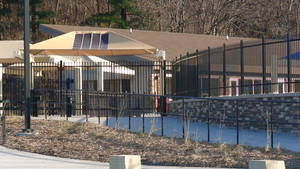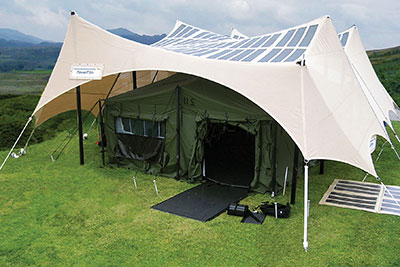Roll Up and Roll Out - Flexible Solar Cells
Interview with
Chris - One of the problems with conventional solar panels is that they're very heavy. They're also fragile and they're stiff and that means it's very tricky to transport them and to install them. A flexible solar cell that you could roll up and then readily transport would be an ideal solution. PowerFilm Solar is an American company and they're doing just this. They're developing what we call 'thin film photovoltaics' and we're joined now by Dr. Frank Jeffrey and also Mike Coon they're from PowerFilm Solar and they're going to explain to us how they work. Frank, hello, welcome to the Naked Scientists.
Frank - Thank you.
Chris - Tell us first if you would, how does your architecture, your flexible cells, actually differ from the rigid ones that we see people putting on their roofs? How do you make them bend?
 Frank - The principle part of the solar cell itself in our cells is amorphous a silicon, which has an extremely high absorption coefficient so that we can have extremely thin semiconducting material that will still absorb a good portion of light. That thin material, even though if it were thick like a crystalline wafer, it would break, in the same type structure when it's thin enough becomes flexible and tends to bend rather than break. So, that's the key part, our basic absorber layer that absorbs the solar energy is only say, 5,000 angstroms thick. So it's quite thin and flexible and we put it on a thin film plastic substrate that is also flexible and adds mechanical support and strength to the solar component.
Frank - The principle part of the solar cell itself in our cells is amorphous a silicon, which has an extremely high absorption coefficient so that we can have extremely thin semiconducting material that will still absorb a good portion of light. That thin material, even though if it were thick like a crystalline wafer, it would break, in the same type structure when it's thin enough becomes flexible and tends to bend rather than break. So, that's the key part, our basic absorber layer that absorbs the solar energy is only say, 5,000 angstroms thick. So it's quite thin and flexible and we put it on a thin film plastic substrate that is also flexible and adds mechanical support and strength to the solar component.
Chris - So when you say it's flexible, how flexible are we talking? Could you roll this up like a newspaper or would it not tolerate that kind of treatment?
Frank - Well, if we have the basic substrate and solar material itself, we can roll it up to a diameter of a pencil and it does just fine. Actually, some applications we do roll that small for storage. That's mostly a space type application but normally, we put a heavier encapsulant on the outside to protect against earth's atmosphere and that means around maybe a 3-inch diameter is what a commercial cell or module that we sell will roll up to comfortably.
Chris - That's still pretty impressive to get it down so small. If we could zoom in with a microscope and just examine the structure of your cells, what would we see? If you could just paint a picture for us so people can appreciate exactly how they're configured.
Frank - Okay. Maybe an electron microscope in order to see it, but we start out with a basic film of polyamide plastic to build it all on. So that's the bottom layer that you would see and that may be a 25 to 50-micron thick plastic film. On top of that, we put a metal layer, principally aluminium, that acts as a back electrical contact. They're able to carry the electrons off the back surface of the solar module or solar cell. Then there are six layers of silicon forming actually 2 diodes, a thick diode in the bottom that absorbs the red light and a thinner diode in the top that absorbs the blue light. By having 2 diodes, we get a higher operating voltage and lower current which means we don't lose as much energy in resistance of the leads coming in and out. Then on top, we have a transparent oxide conductor. It's not all that easy to make something that's both transparent and conductive, but that's the type of film we use. That allows the light to come in and also carries the current off the face of the solar cell. So that's the stack from top to bottom and then clear plastic, generally a polymer encapsulation both front and back to protect it from moisture and outside weathering, and that type of stuff.
 Chris - Ingenious to manage to have something that absorbs both the red and the blue so that you don't waste any energy. How much energy do you extract? If I compared your system head-to-head with one that I could buy off the shelf to put on my roof today, how would the efficiencies compare?
Chris - Ingenious to manage to have something that absorbs both the red and the blue so that you don't waste any energy. How much energy do you extract? If I compared your system head-to-head with one that I could buy off the shelf to put on my roof today, how would the efficiencies compare?
Frank - If you compare to the different technologies out there, ours is quite a bit less per square foot. We generate about 5 watts per square foot as opposed to crystalline silicon which is more in a range of 15 watts per square foot. So, the output is considerably less. Part of the point of our approach also is very low cost manufacturing so that ultimately, we can be competitive in the cost per watt generated and in specific markets that require us to be lightweight and thin such as integrating it in building panels, we can be competitive with crystalline silicon on a cost basis, and in an application basis.
Chris - So no such thing as a free lunch. And Mike Coon, let's bring you in here. I suppose the payback must be that you've got very good portability, there must be many applications for something like this which can be rolled up, packaged away, and taken somewhere where you need instant power on demand in the middle of nowhere.
Mike - That's right. On one end of the continuum, we have our products which serve the portable power market especially well because of the lightweight nature of our material and on the other end of the continuum, talking more about our building integrated products, our larger scale products which can be up to 30 feet or approximately 10 metres long for larger scale building integrated applications. But on the portable area, the light weight is especially important because we can provide power unlike others that can be extremely lightweight, can be portered in, and can be extremely durable. For example, the US Military has shot holes through it and it continues to perform and that's because of this printed interconnect which Dr Derrick Grimmer developed early on for the company.
Chris - Tremendous! So in other words, you've got something which is quite literally bomb proof. How are you actually seeking to use this? Who are your markets? Who is taking this product and deploying it in the field?
Mike - Yes. There are currently three primary market segments that we're serving and a fourth one which we're launching and in process of gearing up for. The existing markets that we're selling in to are the commercial industrial markets, a variety of applications ranging from providing panels for GPS asset tracking on semi-tractor trailers to remote data collection, electric golf carts, campers, RV panels, the whole gamut. Also the military market is very important for us. We've developed products which range on the one hand from small AA chargers to 5 to 60 watt portable chargers to charge everything from ruggedised laptops and notebooks, to medical refrigeration, to remote sensors, as well as in our larger 1 to 3 kilowatt power shade products which provide not only a remote portable power, but also the shade benefits that was mentioned earlier. These are very rugged durable products that can go over existing shelter structures and about four or five man hours can be set up with two to four soldiers.
Chris - So I guess that if you've got say, a military camp, they're in the middle of nowhere, previously, power had to come from someone carting either very heavy batteries or a big diesel generator and all the fuel for it. Now, you've got a system where you could deploy this, it looks because it's flexible, like a tent to all intents and purposes, and it's going to provide mobile power.
Mike - That's right. It's very much designed to meet the power needs of today's war theatre which remote outposts are incredibly important, increasingly important, such as in Afghanistan. We provide energy solutions which can be integrated either independently for targeted use of power as well as integrating part of overall hybrid systems. One of the important aspects of our technology is it does reduce fuel consumption which can be incredibly costly in those remote areas. Reducing fuel consumption reduces convoys, which reduces the cost of the fuel as well as the potential risk of casual losses with those fuel convoys.
Chris - Terrific. Well thank you very much for joining us to tell us about your work. That's Mike Coon and Frank Jeffrey. They're both from PowerFilm Solar with flexible photovoltaic cells that you can even turn into tents.










Comments
Add a comment